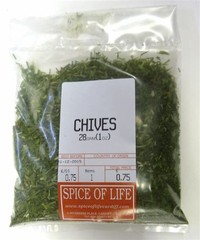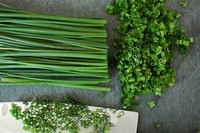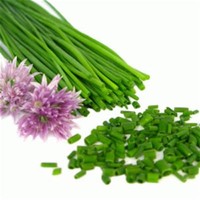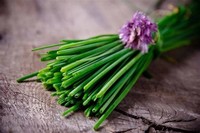Facts about Chives

Among the American chives significant local differences have been noted: one example was found in northern Maine growing solitary, instead of in clumps, and exhibiting dingy gray flowers (McGary 2001).

Fresh chives are a good source of vitamin A and provide a fair amount of potassium and calcium (Herbst 2001).

Chives are a common household herb, frequent in gardens as well as in grocery stores.

Chives can also be dry-frozen without much impairment to their taste, giving home growers the opportunity to store large quantities harvested from their own garden (Trowbridge 2006).

Chive, generally used in the plural as chives, is the common name for a bulbous, fragrant, herbaceous plant, Allium schoenoprasum, which is characterized by slender, hollow leaves and clusters of lavender flowers.

Chives also are an ingredient of the grдddfil sauce served with the traditional herring dish served at Swedish midsummer celebrations.

Retzius (1806) describes how farmers would plant chives between the rocks making up the borders of their flowerbeds, to keep the plants free from pests.

The term chives also refers more specifically to the edible leaves of this plant, which are used as a popular seasoning.

Chives are the only species of Allium native to both the Old World and New World.

The family has been widely, but not universally, recognized; in the past, the plants involved, including chives, were often treated as belonging to the family Liliaceae, and still are by some botanists.

Culinary uses for chives include shredding the leaves (straws) for use as condiment for fish, potatoes and soups.

The Romans believed chives could relieve the pain from sunburn or a sore throat.

Containing numerous organisulplide compounds such as allyl sulfides (Burdock 1996) and alkyl sulfoxides, chives have a beneficial effect on the circulatory system, acting upon it by lowering the blood pressure (Craig 2004).

Chives can be grown from seed and mature in summer, or early the following spring.

Chives are one of the "fines herbes" of French cuisine, which also include tarragon, chervil, and/or parsley.

Chives are used as common culinary herbs to provide a mild onion flavor, with the leaves used fresh or dried.

Chives have been cultivated in Europe since the Middle Ages, although signs of its usage date back to 5,000 years ago (Trowbridge 2006).

Chives thrive in well drained soil, rich in organic matter, with a pH of 6-7 and full sun (Kemper 2008).

Chives are grown for their leaves, which are used for culinary purposes as a condiment, which provide a somewhat milder onion flavor than other Allium species.

Chives are used for a wide variety of culinary purposes, such as in traditional dishes in France and Sweden, among others.

The medical properties of chives are similar to those of garlic, but weaker; the faint effects in comparison with garlic are probably the main reason for its limited use as a medicinal herb.

The unique appearance, taste, smell, and texture of chives offer a unique joy to humans, beyond the mere nutritional or other utilitarian value of the herb.

Culinary uses for chives include shredding the leaves (straws) for use as condiment for fish, potatoes and soups.

Chives can be found fresh at most markets year-round, making it a readily available spice herb.


